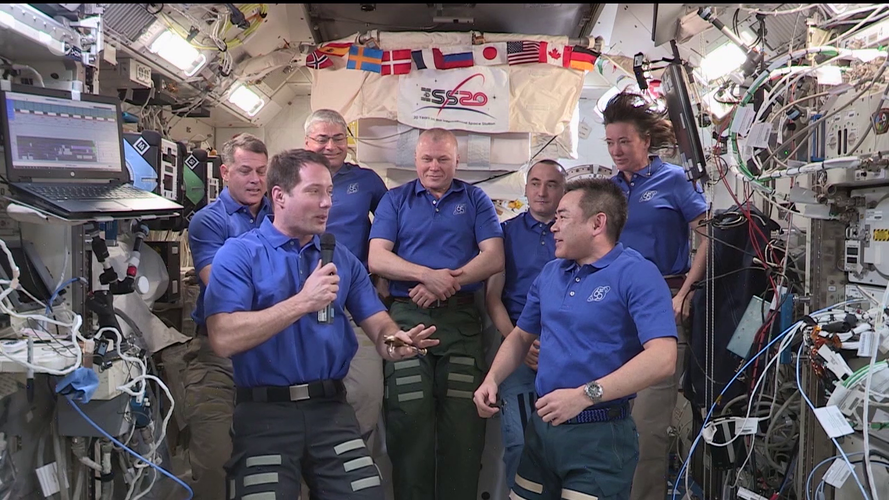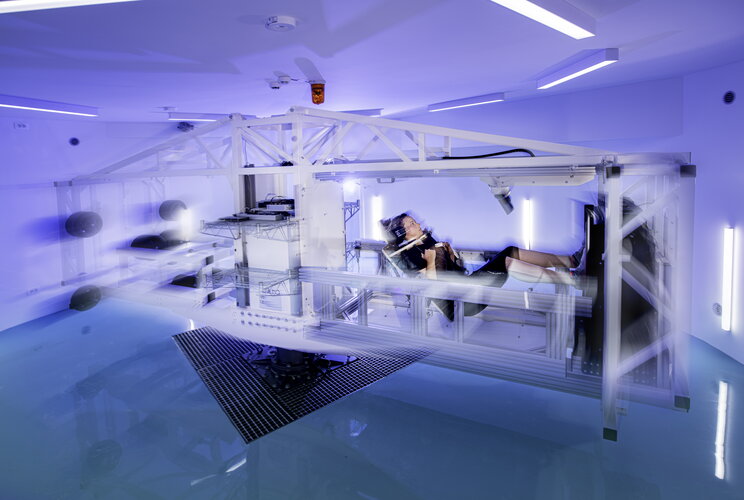
Copernical Team
Russian crew arrives at space station to film first movie in orbit

A Russian actress and director blasted off to the International Space Station on Tuesday in a historic bid to best the United States to film the first movie in orbit.
The Russian crew is set to beat a Hollywood project that was announced last year by "Mission Impossible" star Tom Cruise together with NASA and Elon Musk's SpaceX.
Actress Yulia Peresild, 37, and film director Klim Shipenko, 38, took off from the Russia-leased Baikonur Cosmodrome in ex-Soviet Kazakhstan at the expected time of 0855 GMT, with docking scheduled for 1212 GMT.
"Launch as planned," the head of the Roscosmos space agency, Dmitry Rogozin, said on Twitter.
Led by veteran cosmonaut Anton Shkaplerov, the film crew will travel in a Soyuz MS-19 spaceship for a 12-day mission at the ISS to film scenes for "The Challenge".
A live broadcast on Russian TV showed the Soyuz spacecraft ascending into a cloudless sky.
Working overtime: NASA's deep space atomic clock completes mission

For more than two years, NASA's Deep Space Atomic Clock has been pushing the timekeeping frontiers in space. On Sept. 18, 2021, its mission came to a successful end.
The instrument is hosted on General Atomics' Orbital Test Bed spacecraft that was launched aboard the Department of Defense Space Test Program 2 mission June 25, 2019. Its goal: to test the feasibility of using an onboard atomic clock to improve spacecraft navigation in deep space.
Currently, spacecraft rely on ground-based atomic clocks. To measure a spacecraft's trajectory as it travels beyond the Moon, navigators use these timekeepers to precisely track when those signals are sent and received. Because navigators know that radio signals travel at the speed of light (about 186,000 miles per second, or 300,000 kilometers per second), they can use these time measurements to calculate the spacecraft's exact distance, speed, and direction of travel.
Late-time small-body asteroid disruptions can protect the Earth

If an asteroid is determined to be on an Earth-impacting trajectory, scientists typically want to stage a deflection, where the asteroid is gently nudged by a relatively small change in velocity, while keeping the bulk of the asteroid together.
A kinetic impactor or a standoff nuclear explosion can achieve a deflection.
Thomas becomes Space Station commander
 Video:
00:08:46
Video:
00:08:46
On 4 October 2021 ESA astronaut Thomas Pesquet became commander of the International Space Station, taking over from Japanese Aerospace Exploration Agency astronaut and fellow Crew-2 member Akihiko Hoshide. Thomas will hold this role until shortly before Crew-2 return to Earth in November. Thomas officially accepted his new position during a traditional ceremony, broadcast live from the International Space Station, where a symbolic handover of a key from Aki to Thomas denoted the change of command. The full title of this role is International Space Station crew commander. While overall command of the Station lies with ground-based
Russian crew docks at ISS to film first movie in space (Update)

A Russian actress and director blasted off to the International Space Station on Tuesday in a historic bid to best the United States to film the first movie in orbit.
The Russian crew is set to beat a Hollywood project that was announced last year by "Mission Impossible" star Tom Cruise together with NASA and Elon Musk's SpaceX.
Actress Yulia Peresild, 37, and film director Klim Shipenko, 38, took off from the Russia-leased Baikonur Cosmodrome in ex-Soviet Kazakhstan at the expected time of 0855 GMT, with docking scheduled for 1212 GMT.
"Launch as planned," the head of the Roscosmos space agency, Dmitry Rogozin, said on Twitter.
Led by veteran cosmonaut Anton Shkaplerov, the film crew will travel in a Soyuz MS-19 spaceship for a 12-day mission at the ISS to film scenes for "The Challenge".
A live broadcast on Russian TV showed the Soyuz spacecraft ascending into a cloudless sky.
It will soon be possible to make satellite phone calls with your regular phone

Not all who wander are lost—but sometimes their cell phone reception is. That might change soon if a plan to project basic cell phone coverage to all parts of the globe comes to fruition. Lynk has already proven it can use a typical smartphone to bound a standard SMS text message off a low-earth-orbiting satellite, and they don't plan to stop there.
Formerly known as Ubiquitilink, Lynk was founded a few years ago by Nanoracks founder Charles Miller and his partners but came out of "stealth mode" as a start-up in 2019. In 2020 they then used a satellite to send an SMS message from a typical smartphone, without requiring the fancy GPS locators and antennas needed by other, specially made satellite phones.
The company continued its success recently by demonstrating a "two-way" link this week using a newly launched satellite, its fifth, called "Shannon." They've also proved it over multiple phones in numerous areas, including the UK, America, and the Bahamas.
Eventually, two-way communication means that the signal could eventually be used for voice calls rather than just sending messages in emergencies.
New spin on space research
 Image:
Image:
The ESA-owned Short Arm Human Centrifuge has been upgraded, installed and inaugurated at the Olympic Sport Centre Planica facility near Kranjska Gora, Slovenia. Soon to be home to ESA bedrest studies, this recently enhanced clinical research centre will help further scientists’ knowledge of human physiology in space.
Run by the Jozef Stefan Institute on behalf of ESA, bedrest studies at the facility offer scientists a way to see how the human body adapts to weightlessness. This allows researchers to test techniques, known as “countermeasures”, to counteract the negative effects of living in space.
The Short-Arm Human Centrifuge offers an
UAE to launch probe targeting asteroid between Mars, Jupiter

The United Arab Emirates on Tuesday announced plans to send a probe to land on an asteroid between Mars and Jupiter to collect data on the origins of the universe, the latest project in the oil-rich federation's ambitious space program.
The project targets a 2028 launch with a landing in 2033, a five-year journey in which the spacecraft will travel some 3.6 billion kilometers (2.2 billion miles).
The UAE's Space Agency said it will partner with the Laboratory for Atmospheric Science and Physics at the University of Colorado on the project. It declined to immediately offer a cost for the effort.
The project comes after the Emirates successfully put its Amal, or "Hope," probe in orbit around Mars in February. The car-size Amal cost $200 million to build and launch. That excludes operating costs at Mars.
The Emirates plans to send an unmanned spacecraft to the moon in 2024. The country, which is home to Abu Dhabi and Dubai, also has set the ambitious goal to build a human colony on Mars by 2117.
Explore further
Sounding rocket mission to offer snapshot of sun's magnetic field

Measuring a magnetic field isn't so hard if you're inside of it. Measuring a magnetic field remotely—whether from across a room, across a country, or 93 million miles away—is an entirely different story. But that's exactly what a team of NASA scientists and international collaborators aim to do with the CLASP2.1 mission: measure the magnetic field in a critical slice of the sun's atmosphere called the chromosphere.
CLASP2.1, short for Chromospheric Layer Spectropolarimeter 2.1, will make these measurements from a NASA sounding rocket. Sounding rockets are small rockets that carry instruments into space for five to ten minutes before falling back down to Earth. The launch window for the CLASP2.1 sounding rocket mission opens at 11:30 a.m. MT on Oct. 5, 2021, at the White Sands Missile Range in New Mexico.
The upcoming flight will be the CLASP instrument's third trip to space.
NASA issues contracts to mature electrified aircraft propulsion technologies
 NASA has selected two U.S. companies to support its Electric Powertrain Flight Demonstration (EPFD) that will rapidly mature Electrified Aircraft Propulsion (EAP) technologies through ground and flight demonstrations.
Through the EPFD program, NASA seeks to introduce EAP technologies to U.S. aviation fleets no later than 2035, supporting short-range and regional commercial air travel, as w
NASA has selected two U.S. companies to support its Electric Powertrain Flight Demonstration (EPFD) that will rapidly mature Electrified Aircraft Propulsion (EAP) technologies through ground and flight demonstrations.
Through the EPFD program, NASA seeks to introduce EAP technologies to U.S. aviation fleets no later than 2035, supporting short-range and regional commercial air travel, as w 
